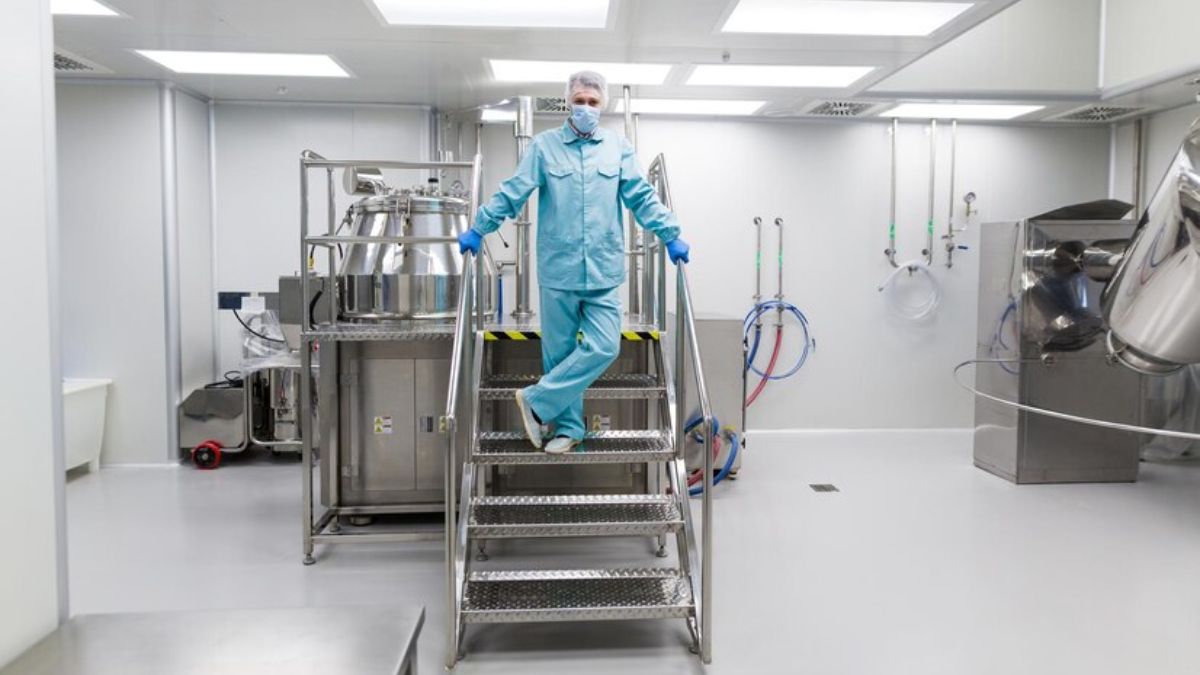HEALTH
The Importance of Cleanroom Facilities in Pharmaceutical Manufacturing

Cleanroom facilities are critical components in pharmaceutical manufacturing, ensuring medical products’ safety, efficacy, and quality. These highly controlled environments are designed to limit contamination, control temperature, and humidity, and maintain cleanliness levels, ultimately safeguarding the integrity of the pharmaceuticals being produced. We will explore why cleanroom facilities by Cleanroom Connection are essential in pharmaceutical manufacturing and their role in protecting consumers, maintaining compliance, and supporting high-level productivity in the industry.
Controlling Contamination in Pharmaceutical Manufacturing
Even the smallest contamination in pharmaceutical manufacturing can lead to product failure or, worse, endanger patients’ health. Cleanroom facilities are designed to minimize contamination risks, utilizing sophisticated air filtration systems, specialized materials, and strict protocols to maintain a clean and controlled environment. One of the most significant risks in pharmaceutical production is contamination by particles, microbes, and airborne particles that could compromise drug formulations. Cleanrooms are equipped with high-efficiency particulate air (HEPA) filters that capture microscopic contaminants before they have the chance to infiltrate the production space.
Moreover, cleanrooms operate under specific standards, such as ISO 14644, which defines the levels of air cleanliness based on the concentration of particles per cubic meter. These standards ensure that manufacturers maintain the appropriate level of air quality, reducing the potential for harmful contaminants. By adhering to these standards and utilizing cleanroom facilities, pharmaceutical companies ensure that their products remain pure, uncontaminated, and safe for consumer use.
Regulatory Compliance and Industry Standards
Pharmaceutical manufacturing is a highly regulated industry with strict product safety and efficacy guidelines. Cleanroom facilities play an integral role in helping manufacturers meet the regulatory requirements set forth by governing bodies. These organizations impose stringent cleanliness and environmental control requirements to ensure that drugs and medical devices are manufactured under conditions that protect the final product from contamination and degradation.
In addition to regulatory compliance, cleanroom facilities help pharmaceutical companies meet industry-specific Good Manufacturing Practices (GMP). GMP is a system that ensures products are consistently produced and controlled according to quality standards. By operating in cleanroom environments, manufacturers can demonstrate their commitment to these standards, reducing the likelihood of regulatory scrutiny or product recalls due to contamination.
The importance of regulatory compliance must be balanced, as any deviation from the required standards can result in hefty fines, product recalls, or even the suspension of manufacturing activities. Cleanroom facilities ensure manufacturers can produce high-quality pharmaceuticals while maintaining compliance with industry regulations, ultimately supporting the company’s reputation and financial well-being.
Ensuring Product Quality and Consistency
Cleanroom facilities play a significant role in maintaining the quality and consistency of pharmaceutical products. Drug manufacturing involves delicate chemical processes that are highly sensitive to environmental conditions. Even minor fluctuations in temperature, humidity, or particulate levels can affect the stability and potency of a drug. By controlling these factors, cleanroom facilities ensure that products are manufactured in a controlled and stable environment, minimizing the risk of product degradation or variation.
Product consistency is especially crucial in the pharmaceutical industry, where even small variations in a drug’s composition can have significant implications for patient safety and treatment outcomes. Cleanroom facilities allow manufacturers to control the production environment precisely, ensuring that each product batch meets the same quality standards. This level of control is essential for both small-scale clinical trials and large-scale commercial production.
Additionally, cleanroom facilities support the development of innovative pharmaceutical products, such as biologics and gene therapies, which require highly controlled environments to ensure their effectiveness. Maintaining product quality and consistency through cleanroom technology is a key driver of innovation in the pharmaceutical industry, allowing companies to market new and groundbreaking treatments.
Protecting Workers and the Manufacturing Process
Beyond protecting pharmaceutical products, cleanroom facilities also play a crucial role in safeguarding the health and safety of workers involved in the manufacturing process. Pharmaceutical production often involves handling hazardous substances, such as potent active pharmaceutical ingredients (APIs) or biologically active materials, which can pose health risks to workers if not properly contained. Cleanroom environments are designed to provide a barrier between workers and hazardous materials, minimizing the potential for exposure.
In addition, cleanrooms are designed with ergonomic considerations to reduce strain on workers and increase productivity. Cleanroom clothing, known as “gowns,” helps to prevent contamination of the production space while protecting workers from direct contact with potentially harmful substances. Workers can safely handle pharmaceutical materials without compromising product integrity or their safety by utilizing specialized cleanroom equipment, such as laminar airflow benches and biosafety cabinets.
Cleanroom facilities also support the continuous operation of pharmaceutical manufacturing processes by reducing the likelihood of equipment contamination or malfunction. A cleanroom’s clean and controlled environment helps prevent dust, particles, or microbes from affecting the performance of sensitive manufacturing equipment, such as filtration systems, reactors, or filling machines. This reduces downtime, ensures efficient production, and ultimately leads to higher productivity and fewer disruptions in the manufacturing process.
Cleanroom facilities are a fundamental aspect of pharmaceutical manufacturing, which is critical in ensuring product safety, maintaining regulatory compliance, and driving innovation in the industry. We have explored how cleanroom environments provide the necessary level of control to prevent contamination, protect workers, and ensure the consistent quality of pharmaceutical products. By investing in cleanroom technology, pharmaceutical manufacturers can safeguard their products, protect consumers, and maintain a competitive edge in an increasingly complex and regulated industry. Cleanrooms will continue to be an essential component of pharmaceutical production, supporting both current manufacturing needs and future innovations.
HEALTH
Sleep Sack Benefits: Better Rest and Safety for Your Little One

As a parent, ensuring your baby sleeps safely and soundly is a top priority. One product that has gained popularity among caregivers is the sleep sack-a wearable blanket designed to keep infants and toddlers warm without the hazards of loose bedding.
Sleep sacks offer several benefits that contribute to better sleep quality and enhanced safety for your little one. Read on.
Promotes Safer Sleep
Traditional blankets can pose serious risks to infants, including suffocation and entanglement. The American Academy of Pediatrics (AAP) recommends avoiding loose bedding in cribs to reduce the risk of Sudden Infant Death Syndrome (SIDS).
Sleep sacks are a safe alternative because they stay securely on the baby, eliminating the chance of covering the face or becoming a strangulation hazard. With a properly fitted sleep sack, babies can move comfortably while parents enjoy peace of mind. Visit a retailer’s shop to learn more about a sleep sack and baby swaddle.
Encourages Better Sleep
Comfort plays a crucial role in how well a baby sleeps. Sleep sacks help regulate body temperature throughout the night by providing consistent warmth without overheating.
They are designed to be breathable, which is essential since babies can’t easily adjust their covers like adults can. This steady comfort helps minimize wake-ups caused by feeling too hot or too cold, leading to longer, more restful sleep.
Supports Healthy Sleep Routines
Sleep sacks can also become a cue for bedtime. Using the sleep sack consistently signals to your baby that it’s time to wind down.
This helps establish a healthy bedtime routine and encourages better sleep habits. Over time, your baby will begin to associate the sleep sack with comfort and rest. This makes transitions to naps and nighttime sleep smoother.
Eases the Transition from Swaddling
Many newborns benefit from being swaddled, but as they grow and begin to roll over, swaddling can become unsafe. Sleep sacks offer a natural transition. They provide a similar sense of security and snugness without restricting arm movement.
This is critical for safety once rolling begins. Some sleep sacks even come with removable sleeves or adjustable features to support this developmental stage.
Practical and Convenient
Sleep sacks are available in various fabrics, sizes, and designs to suit different seasons and age groups. From lightweight cotton for summer to cozy fleece for winter, parents can find a sleep sack for nearly any condition. They’re also easy to clean and typically come with zippers that allow for quick diaper changes without fully undressing your baby.
Try a Sleep Sack Today
A good night’s sleep is vital for both babies and their caregivers. By providing warmth, safety, and consistency, sleep sacks have become an essential item in many households.
Whether you’re navigating the early months or transitioning a toddler out of swaddles, a sleep sack can be a game-changer for nighttime routines. Always ensure you choose the right size and material for your child’s age and climate to maximize the benefits of this simple yet effective sleep solution.
If you want to read more articles, visit our blog.
HEALTH
Ways to Seek Help for Depression and Start Healing

Battling depression can often feel overwhelming. The constant struggle against negative thoughts and emotions can drain the joy out of life, making even the simplest tasks seem insurmountable. However, recognizing the need for help is the first significant step towards healing. There are numerous resources available for those feeling lost in their depression, and understanding how to access these can open the door to a more fulfilling life. From professional therapy to community support, this guide will explore effective ways to seek help for depression.
Professional Therapy Options
Engaging with a mental health professional typically provides the most structured form of support for battling depression. Therapists and counselors offer a safe space where individuals can express their feelings openly. Cognitive-behavioral therapy (CBT) is a highly effective method focusing on reshaping negative thought patterns. Studies show that CBT can significantly reduce depressive symptoms, allowing individuals to gain valuable tools to manage their feelings. Finding a therapist who specializes in depression is crucial, as they can tailor their approach to fit individual needs and situations.
Supporting mental health with medication is another avenue many explore. Antidepressants can help rebalance chemicals in the brain, alleviating persistent feelings of sadness. However, medication is most effective when combined with therapy, providing a holistic approach to treatment. It’s crucial to consult with a psychiatrist who can assess the severity of symptoms and prescribe the right medication. The journey may take time, and working closely with these professionals can enhance the likelihood of recovery.
Reaching Out to Support Groups
Finding community support can be incredibly beneficial for individuals facing depression. Support groups provide a safe environment where people can share their experiences, discuss strategies, and provide mutual encouragement. There are various options available, ranging from in-person gatherings to online forums, each offering a unique way to connect with others who are experiencing similar struggles. Hearing others’ stories can often reassure individuals that they are not alone in their fight against depression.
Many communities offer local support groups organized by mental health organizations. These groups usually focus on specific issues related to depression, allowing participants to dive deeper into their experiences. Participants can learn coping mechanisms that others have found useful, and engaging in these discussions fosters a sense of belonging.
Online support communities can provide anonymity for those who may feel uncomfortable sharing their woes face-to-face. However, it is essential to seek reputable platforms, as the quality and safety of these environments can vary significantly.
Building a Strong Support Network
Having a robust support network that includes friends and family can significantly impact recovery from depression. It’s important to communicate openly with trusted individuals about your feelings and struggles. By doing so, loved ones can provide emotional support and understanding during tough times. Regular check-ins with friends, whether in person or virtually, can help sustain connections that are crucial for emotional health.
Taking the initiative to inform your immediate circle about depression can foster understanding and encourage supportive behaviors. Sometimes, individuals may not know how to help, and openly discussing your needs may guide them in offering the assistance you seek. Every person’s journey is unique. As explained by experts from https://www.denverwellnesscounseling.com/, understanding your emotional and physical boundaries while involving others can enhance your support system in your healing process. Professionals in help you find your authentic self through healing emotional wounds, breaking old patterns, and personal discovery play a vital role in this journey.
Incorporating Mindfulness and Self-Care Practices
Integrating mindfulness and self-care practices into one’s routine can make a tangible difference in mood and well-being. Mindfulness encourages individuals to focus on the present and recognize their thoughts and feelings without judgment. Techniques such as meditation, deep-breathing exercises, and yoga allow for reflection and can help mitigate feelings of anxiety and sadness. Studies indicate that individuals who practice mindfulness report higher emotional well-being, suggesting that being present in the moment can alleviate some of the debilitating effects of depression.
Self-care, encompassing physical and emotional well-being, is equally vital for those struggling with depression. Regular exercise, even in moderate forms such as walking, releases endorphins that promote happiness.
Maintaining a balanced diet and ensuring adequate sleep can significantly impact mood and can empower individuals to take control of their mental health. Allocating time for hobbies can encourage a sense of fulfillment, allowing individuals to explore their interests and passions outside of their struggles.

Deciding When to Seek Immediate Help
Identifying when to seek immediate help is critical for those grappling with severe depressive symptoms. If feelings of worthlessness, hopelessness, or thoughts of self-harm occur, it’s vital to contact a professional immediately. Emergency hotlines and local mental health services can provide timely assistance and interventions that may prevent emotional crises. Recognizing the signs that indicate an urgent need for support can save lives.
Emergency intervention is crucial for those with suicidal thoughts or tendencies. Accessing resources such as crisis centers or contacting a trusted individual can provide immediate relief. Remember that reaching out for help is not a sign of weakness. It is an indication of strength and determination to overcome a difficult situation.
Finding the right path to healing from depression begins with taking the crucial step of seeking help. Whether through therapy, support groups, self-care practices, or alternative therapies, individuals possess various tools and resources to aid their recovery. Building a robust support network can enhance self-discovery and personal growth. While the journey may be challenging, it is essential to remain hopeful and persistent in pursuing the healing necessary to regain a sense of peace and fulfillment in life.
HEALTH
Top 4 Natural Ingredients Commonly Used for Pain Relief Safely

Many people live with pain every day, whether it’s from sore muscles, joint problems, or long-term conditions like arthritis. While over-the-counter medicine can help, it’s not always safe to use it often.
The good news is that nature offers some powerful and safe options to relieve pain. Here are four natural ingredients people commonly use to feel better without relying on harsh chemicals. Read on.
1. Turmeric
Turmeric is a bright yellow spice often used in cooking, especially in Indian dishes. But it’s more than just a flavorful ingredient – turmeric is known for fighting inflammation, which causes pain in the body. Its main compound, curcumin, helps reduce swelling and pain, especially in joints.
Turmeric is safe for most people and can be taken daily in small amounts. It’s available as a powder, tea, or supplement.
To help your body absorb curcumin better, it’s often taken with black pepper, which contains a compound called piperine. Together, they work even better.
Research and explore some new ingredients for relieving pain. There are so many shops open now that can accommodate your inquiry.
2. Ginger
Ginger is another common kitchen ingredient that also works as a natural pain reliever. It has compounds called gingerols and shogaols, which help reduce inflammation and ease discomfort. People often use ginger for joint pain, sore muscles, and menstrual cramps.
You can add fresh ginger to food, drink it as tea, or take it in capsules. Studies show ginger can work just as well as common pain medicine like ibuprofen, but with fewer side effects.
3. Willow Bark
Willow bark comes from the bark of willow trees and has been used for centuries to treat pain. It contains a natural chemical called salicin, which acts a lot like aspirin. People use it to ease headaches, lower back pain, and joint problems like arthritis.
Willow bark is available in tea, capsules, or liquid form. It works well for many people, but if you’re allergic to aspirin or take blood thinners, you should avoid it. It’s always a good idea to talk to a doctor before starting something new.
4. Capsaicin
Capsaicin is what makes chili peppers hot. But when it’s used in creams or patches on the skin, it can help stop pain. It works by lowering the amount of a chemical in your body (called substance P) that sends pain signals to the brain.
Capsaicin is great for nerve pain, arthritis, and even after surgery. Some people feel a slight burning or tingling at first, but this usually goes away. Since it’s used on the skin and not taken by mouth, it has fewer side effects.
Start Using These Ingredients for Your Pain
Natural pain relief options like turmeric, ginger, willow bark, and capsaicin can make a big difference for people who want safe and gentle ways to manage pain. While these remedies come from plants, they still work powerfully.
Just remember – it’s always smart to check with your doctor before adding any new supplement or treatment. With the right approach, natural ingredients can help you feel better, safer, and effective.
If you want to read more articles, visit our blog.

 Cartoon1 year ago
Cartoon1 year agoUnlocking the Potential of Nekopoi.care: A Comprehensive Guide

 Game1 year ago
Game1 year agoExploring Aopickleballthietke.com: Your Ultimate Pickleball Destination

 BUSINESS1 year ago
BUSINESS1 year agoWhat Companies Are In The Consumer Services Field

 BUSINESS1 year ago
BUSINESS1 year agoUnraveling the Mystery of 405 Howard Street San Francisco charge on Credit Card

 HOME IMPROVEMENT1 year ago
HOME IMPROVEMENT1 year agoVtrahe vs. Other Platforms: Which One Reigns Supreme?

 TECHNOLOGY1 year ago
TECHNOLOGY1 year agoThe Guide to Using Anon Vault for Secure Data Storage

 ENTERTAINMENT11 months ago
ENTERTAINMENT11 months agoUnderstanding Bunkr Album: A Comprehensive Guide

 ENTERTAINMENT1 year ago
ENTERTAINMENT1 year agoThe Epic Return: Revenge of the Iron-Blooded Sword Hound
















